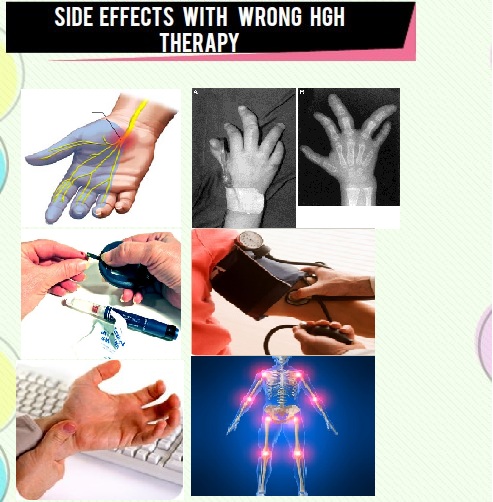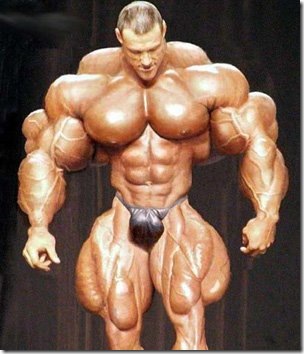Dispelling Growth Hormone Myths
 You might have heard or even read about the use of Human Growth Hormone (HGH). The rumors circulating about HGH is that injectable HGH allow the jaws of a human protrude, enlarge their eyebrows, lead to heart problems or even leads to cancer.
You might have heard or even read about the use of Human Growth Hormone (HGH). The rumors circulating about HGH is that injectable HGH allow the jaws of a human protrude, enlarge their eyebrows, lead to heart problems or even leads to cancer.
These are all myths that are spread about HGH which only discourage you from spending on HGH treatment and rather spend on costly Big Pharma’s drugs which are popularly advertised such as cholesterol, erectile dysfunction & osteoporosis drugs and sometimes have deadly side effects.
Endocrinologists are specialized in the hormonal systems in a human body. With the support of Big Pharma, endocrinologists also do not help the public in eradicating the fear of using HGH.
They create openly or accidentally plenty of negative perceptions about HGH in order to protect their image professionally.
Most of the time it is the baseless fear ‘of the unknown’ which is due to lack of proper education or even due to lack of research to check the benefits of potential hormones. Many of them feel that what ever negative they have heard regarding HGH is actually true.
Endocrinologists learn most of the anti-HGH disorder & misleading publicity during their studies in medical school. They then have to continue a 3 year rigorous training to be a certified endocrinologist.
Following the 3 years training, they have to undergo additional 2 or 3 years training in fellowship. All this training only grooms them to resist HGH treatment.
Once they finish the whole term of medical school, they only come out with full confidence about all what they have learned & feel jealous about their other medical colleagues who would only try to trespass their hormonal turf.
Side effects of hgh therapy
Although the extraordinary advantages of HGH injections therapy and treatment do not come risk free, most of them are associated with huge dosage and often caused by inexperienced anti aging specialists.
Some of the serious side effects that take place when hgh therapy goes wrong are enlargement of the heart or kidneys, beginning of diabetes, hypoglycemia (which happens when the blood sugar is very low), Carpal Tunnel Syndrome (CTS) which occurs due to pressure on the wrist nerve, stiffness of the joints and muscles, insensitivity in the hands, tiredness, bad dreams, High Blood Pressure, pain during subcutaneous injection, tenderness etc.

This occurs usually when doctors are not trained or qualified enough to understand the amount of dosage that has to be given to the patient.
Before beginning to take any supplements or injections for HGH treatment, it is always advised to consult with your doctor relating to the side effects. Apart from the above mentioned side effects, there are some patients who are even allergic to the ingredients that are contained in HGH injections or supplements.
 Allergic reaction which happens are tightness feeling in the throat or the chest, pain in the chest, rashes in the skin or hives, itchiness or swelling in the skin etc.
Allergic reaction which happens are tightness feeling in the throat or the chest, pain in the chest, rashes in the skin or hives, itchiness or swelling in the skin etc.
In case a patient is undergoing any of the above allergic reaction, immediately alert or consult your doctor or emergency medical personnel.
Note – One way to avoid side effects of hgh altogether is to use natural growth hormone releasers instead of going for injections therapy.
8 Most Common Myths About HGH
Myth
IT CAUSES CANCER. Those who use HGH injections can suffer from cancer. The disease riddles the whole body which in turn greatly reduces the life expectancy of a person.
Facts
It is a true fact that cancer has to be taken into consideration as a very serious problem by physicians and researchers who are involved in hormone replacement therapy.
For example, using unopposed estrogen (i.e. without the use of progesterone) for women who are facing postmenopausal often lead to growth in endometrial cancer.
Some of the studies have also demonstrated an increase in incidence of breast cancer with replacement of estrogen whereas other studies have often disputed this study.
 Replacement of testosterone has led to an increase in the chances of prostate cancer. Next bigger worries come with replacement of growth hormone that it can lead to cancer cells divide rapidly and increase the growth of tumor.
Replacement of testosterone has led to an increase in the chances of prostate cancer. Next bigger worries come with replacement of growth hormone that it can lead to cancer cells divide rapidly and increase the growth of tumor.
Some scientific studies do support this idea. Both IGF-1 and HGH provoked lymphoma and leukemia cells grow in culture.
Extra large growth hormone doses also encourage cancer occurance in laboratory animals and promotes development of tumor in rats with bladder cancer.
While in humans, those patients who are suffering from under producing pituitary glands and who are having conventional hormone replacement therapy without growth hormone were found not to be affected from cancer as compared to the general population, whereas patients suffering from acromegaly were found to be having high risk of cancer.
The fact is that if the injections are taken in proper doses, not more then the prescribed maximum dosage, injecting HGH in mature human beings will not show any cancerous symptoms.
A good anti aging specialist will never provide HGH treatment if he finds any chances of HGH leading to cancer.
Besides one way to avoid side effects that come with hgh therapy is to stimulate the body’s own production of growth hormone by using natural releasers and anti aging nutrients.
And growth hormone treatment did not raise the chances of recurrent tumors happening in children who suffered from growth hormone deficiency when they were irradiated for brain tumors, leukemia, or other cancer.
Scientific experiments done on cells in culture and on chromosomes in living animals have not pointed out any proof of mutation with growth hormone – step one in the advancement of cancer.
Yet some experts believe that hgh replacement can possibly stop cancer. Study is still in progress to understand whether HGH can really reduce cancer in mature adults since HGH improves functioning of a human immune system.
Some studies even conclude that taking HGH can reduce prostate cancer in humans. Still the confusion is between the cancer rates & HGH levels in a human body. Children however have not shown any signs or symptoms of cancer using HGH.
IT CAUSES ACROMEGALY

Myth.
People have the fear that HGH can cause acromegaly (uneven growth of bones) in areas such as jaw, forehead, feet and hands. Such growth of bones can make a person look totally out of shape and can invite severe health related problems such as heart disease or even death due to an enlarged heart.
Facts
Acromegaly is not a side effect of growth hormone use. It is a direct effect of deliberate and continuous overdosing, doing everything the hormone is supposed to do but to great excess.
While there are no studies that document increased death among athletes and bodybuilders due to abuse of HGH, physicians and researchers who work with athletes have seen the unmistakable signs of growth hormone overdosing in the bulbous noses and bulging foreheads of jocks and weight lifters.

Andre, the huge man who played the role of a giant in the famous movie ‘The Princess Bride’ was suffering from acromegalic condition.

He was a huge figure standing at seven feet tall and weighed more than 400 pounds. He had massive huge feet and hands. He was a professional wrestler who was able to perform astonishing superhuman stunts like lifting cars until he severely injured his back during his late 30s.
Terry Todd (PhD.) in his article titled ‘Muscle and Fitness’ has described that Andre asked God the reason why he made Andre so strong with superhuman feats but at the same time shortened his life. Andre met his death soon after he reached 46 years of his age.
Andre strength was actually not very normal. He was born with a defect in his pituitary gland thereby giving abnormal growth hormone in his system.
And most of the athletes often risk their lives by completely pumping their body with growth hormone (GH) injections. Acromegalics are the opposite of adults suffering from a deficiency in growth hormone.
Such patients are found to be having a decrease in the quantity of body fat, increase musculature and also an increase in the total quantity of body water.
But as compared to untreated patients suffering from growth hormone deficiency, they are said to be having higher chances of premature death and cardiac problems from heart diseases as compared to the normal population. These people also have a high risk of cancer and diabetes.
But why would an athlete risk disease and death by using steroids and now growth hormone?
In his book Death in the Locker Room, Goldman gave the answer. The question was put to 198 world-class athletes: If you could take a pill that would make you a winner at everything for five years but at the end of that time you would die, would you take it? Fifty-two percent said yes!
The fact is that the growth occurs mostly in children whose bones are still in growing stage and such acromegaly symptoms occur only when the dosage is taken in excess. Normal dosage in adults which is just 14% than that of a child’s dosage does not affect mature people.
Another fact to note is that Adults or mature people who use HGH never grow taller. In fact, injecting HGH in adults can reduce the shrinking process of mature people commonly known as osteoporosis.
HGH can increase the density of the bone which reduces aging effect and compress spinal bones like accordion which eventually cause mature adults to reduce their height by 3 to 7 inches.
There are 7 vertebrae bones in a healthy person’s neck, 12 in their thoracic spine area and 5 in their lumbar spine area, totaling 24 bones.
Assume that only a quarter of an inch is reduced of each bone as part of a mature persons ageing process, it means they reduce in height by 6 inches.
 Research says that HGH can increase bone size by 0.5% upto 1.5% every year, thus preventing any decrease in size of osteoporosis fractures. A patient with high rheumatoid arthritis faced a full fledged remission after just 6 months of HGH treatment.
Research says that HGH can increase bone size by 0.5% upto 1.5% every year, thus preventing any decrease in size of osteoporosis fractures. A patient with high rheumatoid arthritis faced a full fledged remission after just 6 months of HGH treatment.
Even children who are short in height or who are often called as dwarfs have increased in height using HGH treatment but the height gain cannot be compared to a full fledged height.
Again, the doses provided to mature humans are just 14% of the actual dose that is administered to short height children.
Myth
Growth hormone is a steroid
Fact
Growth hormone is not an anabolic steroid although it has similar effects.
Anabolic steroids are artificially manufactured products that behave in your body similar to male sex hormones; they are not available in any natural form. Hgh is not a steroid.
It is found naturally in the body and produced by the pituitary gland, vital for development in childhood and a crucial aspect of keeping normal body structure and performance all the way through existence.
But growth hormone and anabolic steroids have the same effect on body composition, decreasing fat and increasing muscle mass.
 It is not surprising that growth hormone has become the drug of choice among athletes who are always trying to push the envelope of muscle mass and strength. That was why they abused “anabolic steroids“.
It is not surprising that growth hormone has become the drug of choice among athletes who are always trying to push the envelope of muscle mass and strength. That was why they abused “anabolic steroids“.
But when testing began for anabolic steroids in competition, they had to turn to a compound that would have similar effects but would not be detectable. Growth hormone was the perfect answer. It cannot be detected in urine, and invasive blood testing is not permitted in competition.
We feel that the use of growth hormone in young bodybuilders and athletes who have normal levels of GH is abusive, unethical, and dangerous. And it may be ineffective.
In a recent study of experienced weight lifters who attempted to bulk up even further, short-term treatment with either growth hormone or IGF-1 did not increase the rate of muscle protein synthesis or decrease the rate of protein breakdown, changes in metabolism that promote muscle growth.
Growth hormone can cause edema and carpal tunnel syndrome.
 Carpal tunnel syndrome and joint aches and pains are all due to the water-retention effects of growth hormone.
Carpal tunnel syndrome and joint aches and pains are all due to the water-retention effects of growth hormone.
These are side effects and they have occurred in the past and continue to occur when physicians or researchers try to push the dosage.
Rudman found that the dosages used in his study, which are several times that which are now recommended, cause these side effects.
The recent double-blind study by Maxine Papadakis and associates at the University of California in San Francisco, which followed up on Rudman’s study used the identical dosage and, not surprisingly, got many of the same adverse effects. These included lower-extremity edema and joint pain.
Two growth hormone recipients (and two placebo recipients!) developed tender breasts, although none of the men in the study developed gynecomastia. There was no incidence of carpal tunnel syndrome, and all the side effects disappeared when the dosage was lowered by 25 to 50 percent.
Some groups have reported no side effects at all, while others have reported an incidence of side effects that ranged from 5 percent to about 70 percent. The side effects appear to disappear when low dosages are used and the dosages are tailored to the individual patients.
In one study of twenty-two GH-deficient patients, who were given about 0.5 IU per kilogram of body weight per week, only one person developed edema and there were no other adverse effects.
In another study four patients on the same dosage developed edema, which went down when the researchers lowered the dosage to .25 IU per kilogram of body weight. The study by the Dutch team headed by Hans de Boer revealed that the optimum dosages was about 1.10 IU a day.
They recommend starting with an initial dose of .5 IU a day and raising it in monthly increments of .5 to 1 IU until a maintenance dose of approximately 1.10 IU a day is reached to prevent overhydration.
This dosage is about 40 to 60 percent lower than that used in most previous studies. Yet the effects at these lower dosages were comparable to those of the highest dosage.
The take-home message is that everyone is different. By starting low and slowly building the dosage in small incremental steps until a maintenance dose is reached, the body has the time it needs to adjust to the added hormone.
Myth.
IT CAUSES DIABETES. Use of HGH treatment in humans can cause diabetes and other medical complications.
Facts.
If the HGH dosage is proper, there are no chances of diabetes. There is a chance in cases where the hormones are injected more than the required recommended dose.
Though research is still been carried out, some experts strongly believe that HGH can in fact reduce diabetes in a patient since clinical result has proved that injecting HGH reduces body fat (which is a main factor behind diabetes).
Myth.
IT CAUSES HYPOGLYCEMIA. Unlike people with diabetes, whose bodies fail to produce enough insulin, people with hypoglycemia produce too much of the substances resulting in glucose levels that are too low. The claim is that HGH forces the body to produce more insulin than necessary.
Facts.
These problems rarely happen in healthy children, and the same is true for mature HGH patients. With proper monitoring the blood of patients during regularly scheduled follow-up visits, any increase in insulin levels would be noticed and required steps can be taken.
Myth.
IT CAUSES JOINT PAIN. People suffer severe joint pain as a result of injectable HGH, causing excessive growth throughout the body.
Facts.
Anyone complaining of joint pain may have exceeded the intake of appropriate doses.
Myth.
IT CAUSES EXTENDED BELLIES. Bodybuilders who use HGH experience extended bellies, an unsightly physical condition.
Facts.
Some bodybuilders who experience this condition had administered HGH in excessive amounts.
Myth.
IT CAUSES PITUITARY TUMORS. Tumors grow in or on the pituitary gland, cutting off or accelerating production of vital hormones, including HGH, and causing significant health problems.
Facts.
Injectable HGH, when administered in proper doses, does not cause anything resembling such tumors.